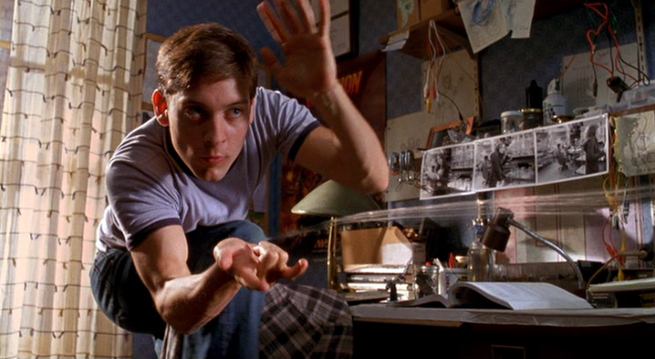When Sony’s Spider-Man hit cinemas in 2002 after languishing in development hell for nearly a quarter of a century, it became the third highest grossing film of the year (behind behemoths The Lord of the Rings: The Two Towers and Harry Potter and the Chamber of Secrets), and was roundly praised by audiences and critics alike. The casting of Tobey Maguire was particularly well received, with many fans instantly adopting him and his baby blues as the true embodiment of Peter Parker.
However, director Sam Raimi made one creative decision that was to prove extremely controversial: The introduction of organic web-shooters. Rather than have Parker design and build ingenious web-slingers as he did in the comics, Raimi thought it stood to reason that our hero would have developed an arachnoid mutation, which caused him to spurt goo copiously from holes in his wrists. While many a Spider-Fan took umbrage at this deviation from the source material, I would argue that there is a more glaring problem than straying from canon here.
Wrists? Oh no, my friends. A spider’s silk spinnerets are generally located on the underside of the abdomen, and to the rear. More specifically between its anus and its gonads. So, No man’s land basically. The gooch. Imagine, if you will, Maguire swinging around New York, the custom undercarriage flap in his Spidey suit fluttering in the wind, firing sticky white fluid from his posterior. Not so cute now, is he?
Of course there is another possible explanation for the wrist ejaculate, one which is equally horrifying. Suppose those aren’t spinnerets at the end of Peter’s arms. You know the appendages spiders have either side of their fangs which look like little arms with blobs stuck on the end? Fantasy novelist and lapsed entomologist, Richard Roberts, explains what they’re for:
“Pedipalps are fun. They are the taste organ for spiders. They are the hands, manipulating food and anything that their mouth has to deal with. Pedipalps are also the sex organ in male spiders. The female spider’s gonopore is underneath its abdomen. Technically, so are the male’s gonads. Making those two meet is…difficult, so the tips of a male spider’s pedipalps are specialized into big knobs. They transfer sperm into their pedipalps, and use those to insert it into the gonopore. The shape of a male spider’s pedipalps can be very complicated, because the gonopore and pedipalp fit together like a lock and key. Yes, a male spider’s pedipalps are his tongue, his fingers, and his penis all at the same time.”
Yup! Because male spiders don’t have a penis, they spin a silky ‘sperm web’ which they ‘unload’ onto, before using their little ‘fists’ to stuff the package up inside Mrs. Spider. Charming. And although some species of arachnid do perform elaborate mating dances, it’s not quite as romantic as an upside down kiss in the rain. Neither is being taken out for dinner by a guy who has to vomit digestive enzymes over his meal before sucking it up, although you probably wouldn’t want to skip dessert. Probably best if we don’t dwell on what that radioactive bite probably did to poor Peter’s…ahem…peter.
So what other icky body modifications could Raimi have bestowed upon young Parker to make him more authentically spidery? We all know Spider-Man can scale vertical surfaces with ease, but the how is a little more mysterious. I consulted eminent scientist and imbiber of Scotch, Incidentally Bentley, to find out what Pete would need to pull off this superpower for real:
“To walk up walls, he would need plenty of scopulae. These are the tufts of hair between the paired claws at the end of a spider’s legs. These bristles can branch up to one thousand times.”

These scopulae would allow our hero to stick to even the most glossy of sheer surfaces, and the adhesion would be so great, it would enable him to do so while supporting up to one hundred and seventy times his own weight! That’s going to come in handy when taking advantage of Spidey’s super-strength. Remember how he managed to snatch both Mary Jane and a tram car full of people from plunging to a watery death? However, with great power comes…some really gross biology. Bentley explains:
“Spiders don’t really do muscles and totally skip leg day in favour of hydraulics. They can radically change the blood pressure in their appendages and it is by firing loads of blood into their legs that jumping spiders leap so far. Problem is, a dewy meat sack is not going to cut it. You need an exoskeleton. That’s why spiders go crunch when your cat eats them.”
So a real Spider-Man would need a husky structure on the outside, rather than an endoskeleton, and an open circulatory system. In other words, instead of having blood in nice, neat veins, he’d essentially be a sloshy, crispy-coated bag of soup with organs floating about in it. Sexy.
So on reflection, maybe it’s a good thing that the next big screen iteration of Spider-Man looks set to eschew the body horror of Raimi’s vision for a return to gadgetry. Rumour has it that Captain America: Civil War will see young Peter Parker donning some tech designed by none other than Tony Stark.
So what do you think? Do you prefer Spider-Man the engineer with all his humanity preserved, or do enjoy your superheroes a little on the Brundlefly side? Let us know in the comments or on Twitter.

